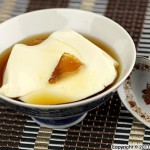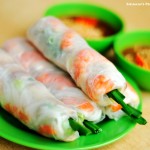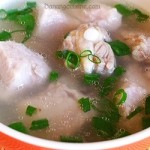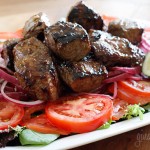Ingredients
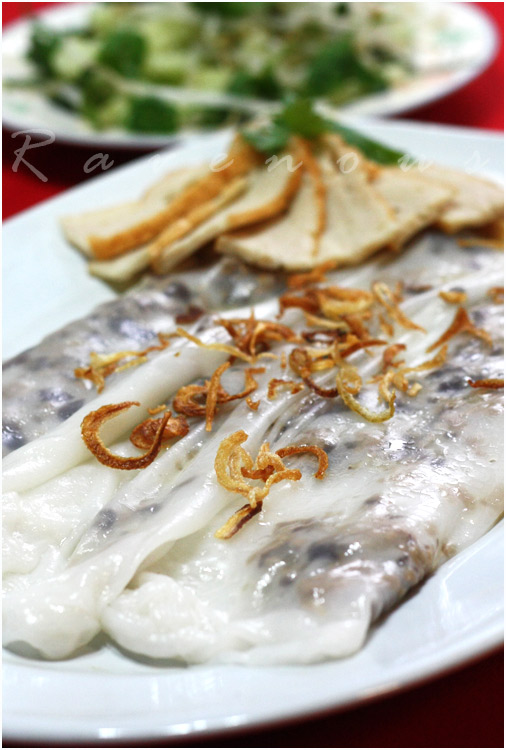
For the filling:
– 300g ground pork(0.7 lb)
-1/2 large onion, chopped (½ cup)
-30g dried woodear mushrooms (black fungus)= 1/3 cup
– 1tsp salt & pepper

For the rice crepes:
-1 pack Banh cuon flour 400g (OR: 200g rice starch + 200g tapioca starch)
-1 liter water(=4 ¼ cup or 1 quart )
-1 tbsp vegetable oil
– ½ tsp salt
For Hanh phi
200g red shallot, sliced into1cm thick (~2 cup) (It can be replaced by onion slices)
½ tbsp tapioca starch

For garnish: (choose your favorite)
-Beansprouts/cucumber/fresh greens/ Asian basils
-Pork floss (cotton meat)
-Vietnamese ham “Cha Lua”
Directions
Making fried shallot “hanh phi”
Make sure the shallot slices are very dry. Coat with tapioca starch.
Heat a generous amount of vegetable oil in a pan. The oil should be enough to cover the shallot. Test the correct temperature of the oil using shallot slice or a chopstick. If you can see bubbles around it, the oil has the right temperature. The oil should not be too hot because the shallots would burn. Fry until they are slightly golden brown, quickly remove from the pan. The oil is nicely fragrant so we will use it again for the next steps. Spread the fried shallots on the kitchen paper to drain off the excess fat. When it cools down it will become crispy.
Making the fillings
Season minced pork with salt and pepper. Mix well.
Soak dried woodear mushrooms in boiling water and leave for 15 mins. They will grow bigger and become softer. Then wash them well under cold running water and remove the stem if any. Cut them into thin strips and chop them up.
Next heat 2 tbsp of the same oil in a pan an fry the chopped onion until slightly golden, then add the minced pork and cook under medium high heat until it is done. Use a spatula to break the pork to avoid any chunk. The pork is cooked when the color changes completely. Then add the chopped mushroom and cook for 30 seconds and take off the heat.
Making rice crepes
Dissolve the banh cuon flour with 1/2 tsp of salt, 1 tbsp vegetable oil and 1 liter of water. Stir well until the flour is dissolved. In order for the rice crepe to have a smooth silky texture, let the batter rest for at least 1 hour, or better overnight.
Traditional method in Vietnam: They have a pot filled half full with water. The piece of cloth is stretched and tied tightly on top of the pot. They bring the water to a boil, and ladle on some batter and spread it around then cover and steam for a minute. Then the rice crepe is carefully lifted and transfered onto a tray with a thin bamboo stick. After that they add the filling and roll. The rice crepe is paper thin, and really delicate.
Home-made method: (because we do this, we need need more water in the batter than the traditional steaming method. That’s why mix the flour with 1liter of water instead of 750ml as suggested on the package)
Grease the pan and the flat surface with a very thin layer of oil.
Heat the pan over medium high heat until it is nice and hot, then pour in about 1/4 cup of the batter.
Tilt and the pan in a circular motion to cream an even round crepe.
Cover and cook for 1 min.
Most likely you will throw away the first crepe because your pan is not used to it yet the first roll might be oily and ugly. But the second one will be better.
When the crepe is cooked, you “flip” it out onto the tray and continue to make another crepe while the pan is still hot.
If you have a good non-stick pan, you only need to grease the pan just once for the first time only. If your pan is not that good, maybe you need to grease it again after 4-5 crepes. Don’t grease the pan and the tray after every crepe because that would be too oily, and you want the crepe to be “steamed” and not “fried”. Remember to always stir up the batter before making a new crepe.
While waiting for the new crepe to steam, add filling and roll the previous crepe.
It should take about 40-50 mins to finish the batter if you continue this process successively. So be patient 🙂 The more skillful you get, the thinner you can make the crepe.
The rolls should be very thin, somewhat translucent so you can somehow see the filling through the outer layer, and have a smooth silky texture.
Assembling the dish
Cut the steamed rice rolls into bite size pieces. Top up with fried shallot.
You can serve it with blanched beansprouts meaning bean sprouts that is soak in boiling water for 30s, or you can also serve it with chopped cucumber, fresh vegetables and herbs like asian basils, with vietnamese ham Cha Lua etc. And of course some light dipping fish sauce “nuoc cham”.
Banh cuon has many variations. It is served differently in different regions in Vietnam. In Danang, it is topped with cotton meat and fried shallot, served with a platter of fresh vegetables, Vietnamese ham and they also put some carrot and green papaya slices in the light dipping fish sauce.
Post Views:
8,887

